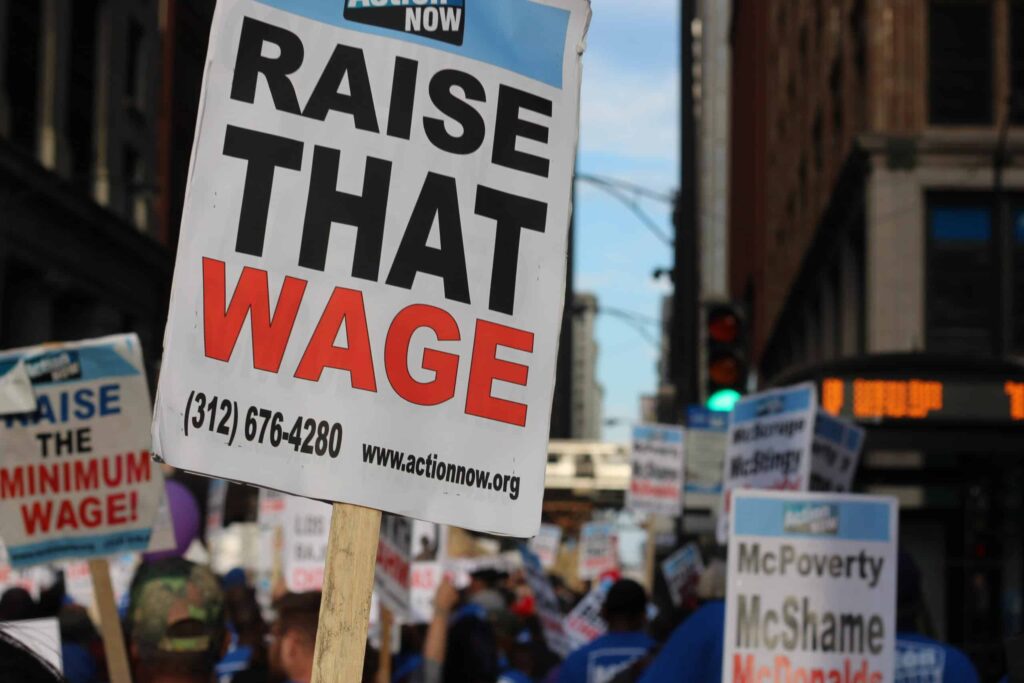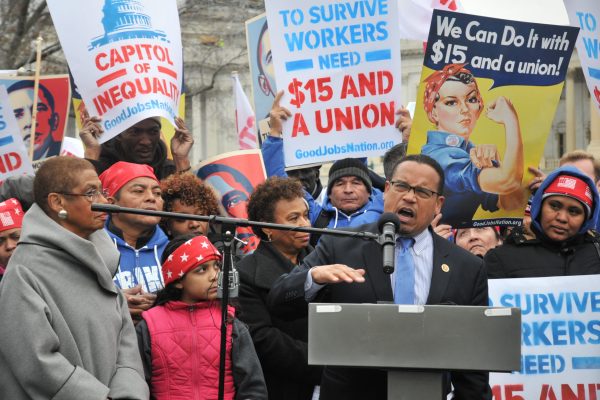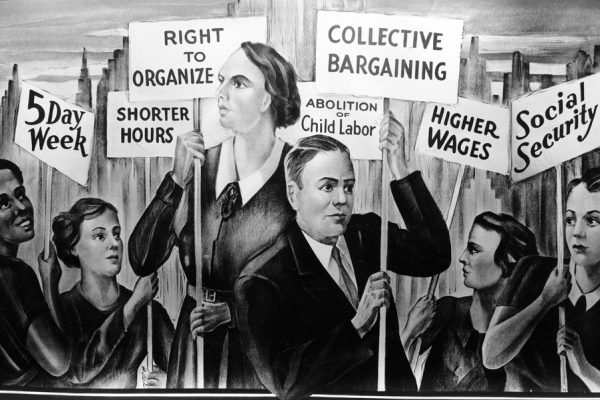How Antitrust Failed Workers
Eric A. Posner
Oxford University Press, $29.96 (cloth)
A little less than a decade ago, after spending several years as a union staffer helping workers organize in low-wage industries, I was assigned to conduct research in support of fast food workers on strike for a $15 minimum wage and a union. It was exciting; workers were making bold demands on some of the most powerful corporations in the country, including a wage increase to double the current level of the Federal minimum wage. Too bold, in fact, for many. Democratic policymakers balked at $15. And with rare exceptions, the entire academic economics profession was opposed. Economists argued that if we forced employers to pay higher wages, they would simply hire fewer workers. A famous liberal economist even wrote a New York Times op-ed opposing $15. However, the Fight for $15 largely sidestepped the debates, so important to economists, about whether higher minimum wages would result in zero or nonzero job loss. Instead, it articulated a social vision of worker rights: workers had the right to the dignity of a living wage—their living in poverty was intolerable in a rich society.
Then a funny thing happened. Ignoring the experts, cities started passing $15 hourly minimum wage ordinances, and the economic sky didn’t fall. Unemployment didn’t skyrocket, or even rise perceptibly. The economists were wrong. Intellectually honest if initially mistaken, economists looked for theories that would better reflect reality, and a previously out-of-fashion theory known as “monopsony” became the new reigning conventional wisdom. Some economists realized they had made a mistake in assuming that labor markets were competitive, meaning wages were set by impersonal forces of supply and demand. According to these “perfect competition” models, employers had no power over wages: if they tried to cut salaries, all their workers would quit. Under the previously assumed competitive conditions, employers competed vigorously for workers, bidding up wages until the pay rate just equaled the amount of value workers contribute to their employer (their “marginal product”). Under these conditions, employers already paid workers as much as they could afford to, with no room to raise wages. Legislated minimum wages, as the Fight for $15 called for, would just force them to lay off staff.
However, economists now understand that labor markets are generally not competitive: workers are not particularly mobile between employers for a variety of reasons (for example, it’s costly to search for a job and workers value non-wage aspects of the workplace), and in many cases labor markets are highly concentrated. Because of these factors, workers are rather limited in their choice of employer, and employers have some latitude to unilaterally set wages. The role of market concentration in contributing to monopsony power is important because it implicates lax enforcement of antitrust law as one cause of wage suppression. The antitrust establishment, which had until recently largely ignored labor market issues, began to take notice.
It is in this environment of shifting conventional wisdom that Eric A. Posner’s How Antitrust Failed Workers arrives. Posner, a professor at the University of Chicago School of Law, expertly lays out the theory of monopsony, explains the harms of monopsonsized labor markets (lower wages, higher prices, and slower growth), and offers numerous ways antitrust can do better by workers. Workers and worker advocates interested in learning more about monopsony and the basics of antitrust law will find the book informative and useful.
How Antitrust Failed Workers is at its best when indicting the current antitrust establishment for failing to live up to its own goals and harming workers in the process. Posner castigates the antitrust agencies and courts for ignoring workers, pointing out that mergers are virtually never blocked, or even challenged, for labor market effects. He also proposes several antitrust reforms, advocating for non-compete clauses to be made presumptively illegal and listing several causes of action workers should have at their disposal to sue employers for anticompetitive conduct under the Sherman Antitrust Act. These include mergers in concentrated markets, use of non-compete and related clauses, misclassification of employees as independent contractors, and violating workers’ union rights under the National Labor Relations Act. These reforms would be valuable tools for workers fighting wage suppression.
Despite the title of the book, Posner ventures far beyond the pathologies of antitrust and wades into labor and employment law as well. He is no neoliberal, and many of his recommendations here are progressive and even interventionist, such as his approval of industry-specific wage boards as anti-monopsony tools. However, the limits of his approach become clearer as he gets more specific about labor law reforms. While he excels at calling out establishment antitrust for failing to live up to its own goals as they affect workers, he ultimately shares those goals, and so shares in their shortcomings as well.
In particular, Posner is steadfast in sticking to the monopsony frame—his prescriptions for labor law, like his antitrust recommendations, are rooted in monopsony theory. When he argues repeatedly that millions of Americans are paid thousands of dollars less than they should be paid, his criteria is clear: policy should be concerned when (and only when) workers are paid below their marginal product, or the amount they would be paid if reality conformed to the economic model of perfect competition.
For example, he supports minimum wages, but only if they are enacted in monopsonistic labor markets and not set “too high.” Here Posner’s antitrust vision clashes with the historical rationale of wage and hour laws, which never had the goal of merely correcting market failures. Rather, they aimed to actively shape labor markets by guaranteeing rights, protecting vulnerable classes of workers, and preventing companies from gaining an unfair competitive advantage because of socially unacceptable and exploitative labor practices.
For example, the preamble to the Fair Labor Standards Act of 1938 (FLSA) stated the law’s intention to regulate labor conditions in accordance with “the maintenance of the minimum standard of living necessary for health, efficiency, and general well-being of workers,” declaring that employers who violated these standards were engaged in an “unfair method of competition.” Moreover, while monopsony theory implies a static ceiling for wage increases at the level of workers’ marginal products, backers of the FLSA believed that the law would dynamically push employers to become more efficient and innovative. For example, by introducing new labor-saving technology, employers would raise the productivity of their employees. At the macroeconomic level, minimum wages would also shift workers from low-productivity to high-productivity industries, generating broadly shared economic growth. Economists supportive of the FLSA noted that workers are also consumers. If they earned higher wages, they would boost demand for goods and services throughout the economy.
The monopsony-as-market-failure frame also shapes Posner’s approach to unions. According to Posner, “the theory [behind unions] was that if workers banded together, they could use legally mandated collective bargaining and the threat of strikes to prevent employers from paying them monopsony wages.” However, this theory would have surprised generations of union leaders, who have long articulated their cause in terms of broad social values such as solidarity and industrial democracy, and rights like safe workplaces and freedom from arbitrary power. For example, Posner downplays “just cause,” or protection against arbitrary dismissal, as ineffective against monopsony-level wages, and warns that job protections might inhibit labor mobility. But the point of just cause provisions, either in union contracts or under state laws, is not to raise wages at all, but rather to give workers protections against an employer’s arbitrary power within the authoritarian hierarchy of the workplace. The justification for just cause lies not in correcting market failures, but rather in extending due process rights against arbitrary punishment into what Elizabeth Anderson calls the employer’s “private government.”
Moreover, unions have never sought to set workers’ wages to the level of their individual marginal products. To the contrary, unions have instead enforced collective norms of fairness and solidarity by means such as compressing the wage distribution within workplaces. This has even meant holding back wage growth for the highest paid, high-skill workers (say, skilled machinists) while supporting high wages for workers in lower productivity jobs (say, janitors). As the garment union’s in-house economist Solomon Barkin pointed out long ago, production was a joint undertaking, with one person’s contribution dependent on another’s. Determining any individual’s precise contribution was impossible. The role of a union was not to get the janitor and skilled machinist each paid according to their precise marginal products, but to distribute the fruits of that joint production process democratically and fairly. These were not fringe ideas confined to social democratic unions in the CIO either.
A 1945 memorandum from the U.S. War Labor Board argued that the goal of federal policy was to raise wages “to increase hourly earning generally in proportion to the average increase of productivity in the economy as a whole” rather than within firms or even industries. Similarly, while Posner suggests minimum wages should vary from market-to-market to reflect local conditions, a longstanding union practice is to equalize wages for the same job across markets, among other reasons to prevent employers from threatening workers in high-wage regions with establishing “runaway shops” in lower wage environments. (To be fair, Posner recognizes regional subminimum wages invites such “gaming by employers”). For example, one of James R. Hoffa’s great accomplishments as president of the Teamsters was dramatically raising wages for southern truck drivers, achieved in part by moderating the wage demands of the union’s highest paid locals on the west and east coasts.
Finally, antitrust-as-correction-of-market-failure is a limited vision even of antitrust itself. Throughout U.S. history, the goal of economic regulation, including antitrust, was never merely to correct deviations from an economists’ blackboard vision of a perfectly competitive market ideal. Rather, from the early nineteenth century, Americans designed economic policy to structure and shape markets to serve public ends. The question was not whether to have “more” or “less” competition, but what kind of competition? Under what rules? The Sherman Act of 1890 was no different, and later antitrust laws proceeded even more explicitly in the same vein. The authors of the Clayton Antitrust Act of 1914 intended the law’s list of prohibited unfair practices to function as the first step toward setting rules for fair and unfair methods of competition. The goal was to steer businesses toward competing based on superior innovation, quality, and price, by outlawing those “unfair” methods of competition that had no justifications in economic efficiency. The aim of the Federal Trade Commission Act, written as a companion to the Clayton Act and passed at the same time, was to continually update the Clayton Act’s list of unfair methods of competition to keep up with evolving business and technological conditions.
Now, for the first time in a generation, employers are struggling to fill job vacancies. Restaurant and trucking company owners clamor for something to be done about the “labor shortage,” blaming overgenerous unemployment benefits for denying them access to the labor they have until recently been able to take for granted. Strike activity is also reaching recent historical highs, with high-profile strikes involving tens of thousands of workers occurring at Frito-Lay, Kellogg’s, Warrior Met Coal, St. Vincent Hospital (Worcester, MA), and John Deere. Meanwhile, progressives celebrate what they see as a rare tipping of the scales toward labor, calling for government to go even further to empower workers even as they debunk flimsy claims about the role of unemployment insurance in disincentivizing work.
However, despite worker quit rates rising to record highs in industries such as accommodation and food services and an uptick in the number of workers on strike, the overwhelming evidence shows that employers still hold the upper hand in labor markets. After months on strike, St. Vincent and Warrior Met Coal workers still haven’t won fair contracts. Meanwhile, employer complaints about “shortages” signal that they are still exploiting their monopsony power. Unlike employers in competitive labor markets, who simply hire all the workers they need at the market wage, monopsonists with wage-setting power resist raising wages to hire new workers because they would also have to raise pay for their incumbent workers as well.
Given such pervasive monopsony, restoring competitive conditions is an attractive policy goal. But does the role of policy end there, with the correction of these market failures? Answering mostly affirmatively, How Antitrust Failed Workers shows how much this framework can help workers. In this moment of rising worker expectations and even unrest, workers and friends of labor should not settle for Posner’s underlying vision.
As economic historian Karl Polanyi pointed out in the 1930s, markets do not exist outside of law and policy. Rather, laws create and structure markets. The questions are: Who sets the rules, and to what ends? Should policy favor more power for workers? How much more in salary should a CEO make than a production worker or cafeteria worker? Do the benefits of higher wages outweigh the costs? These are fundamentally social and political questions to be hashed out in legislatures and through collective bargaining, but frameworks like Posner’s transform them into technical ones focused on restoring textbook market conditions. If our goal is to direct and shape markets and business behavior to serve democratic public ends, we should ask more of policy than merely nudging real markets to conform more closely to the ideal of perfect competition.









